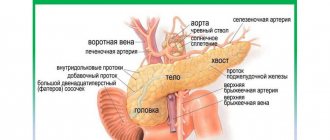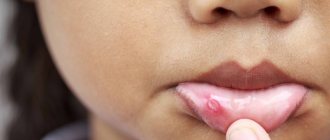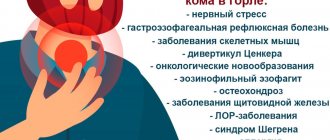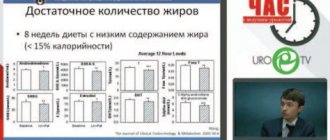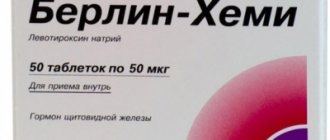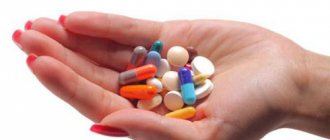Types of pancreatitis
In acute form of pancreatitis
a person experiences pain in the upper abdomen. Usually the pancreas hurts after fatty foods and alcohol. Pain in acute pancreatitis can be barely noticeable or severe (sometimes even radiating to the shoulder blade or chest). During an attack of acute pancreatitis, there may be nausea, vomiting, diarrhea, or constipation. The skin may turn yellow due to poor bile flow.
For chronic pancreatitis
pain in the upper abdomen, radiates to the back, left side of the chest, and lower abdomen. The pancreas hurts after fatty foods, alcohol or frequent stress. With chronic pancreatitis, nausea (sometimes vomiting), bloating, loss of appetite, and problems with stool (diarrhea or constipation) appear.
In chronic pancreatitis, periods of exacerbation alternate with periods of remission. If pancreatitis is not treated, exacerbations occur more often, intestinal disorders are observed, food ceases to be digested normally, and the person loses weight sharply.
Often, with chronic pancreatitis, various complications develop: bleeding in the stomach, abscesses and cysts, liver damage, enterocolitis, diabetes mellitus and even oncology. That is why, at the slightest problem with the pancreas, you need to consult a doctor as soon as possible.
Acute pancreatitis
It’s time to move on to the internal organs, in the sense not to the police, but really to the internal ones. Today a new topic is pancreatitis. This is a disease that I usually treat as a concomitant problem: pancreatitis after peritonitis, after bleeding ulcers and other sores. But sometimes patients are brought to us with pancreatic necrosis, pancreatogenic peritonitis, pancreatogenic shock. All of these conditions pose a real threat to life.
Pancreatitis is one of the most common diseases in a surgical hospital. If until the 2000s it was in third place after cholecystitis and appendicitis, then since 2005, at least in Moscow, it confidently ranks second in “popularity”.
In general, for me, a resuscitator, such patients are more grateful than, say, heart attack patients. The fact is that patients with a heart attack who have survived the first day of fear and pain feel relatively well, they are not even bothered by pain and weakness. Therefore, they are ready to run on a treadmill even now, they are brave, they do not listen to the medical staff - it is very difficult to convince them that the post-heart attack condition is fatal.
Patients with pancreatic necrosis are another matter. These patients know for sure that they are sick. They are in such pain that they are ready to endure any tests from the medical staff, just to “let go.”
- Nikolaich, today we need to swallow the hose. “What, will it help?...” “Kanesh, it will help,” and the poor fellow, grunting, endures our fanaticism.
In general, the disease is not only painful, but also incredibly dangerous - it’s like the explosion at a Chinese chemical factory in Harbin in 2005, when toxic substances struck the local population and poisoned everyone who lived along the bed of the Songhua River. So what is it?
What happens in the body
Science defines pancreatitis as a nonbacterial (sterile) inflammation of the pancreas. Gland cells are damaged by their own aggressive enzymes, with the appearance of dead areas, followed by infection and involvement of surrounding tissues (abdominal cavity and retroperitoneal space) in the pathological process.
The pancreas itself (lat. pancreas), in accordance with the name, is located slightly behind the stomach, bending like a horseshoe. Inside this gland, from the tail to the head, the Wirsung duct passes, where the secretion is collected, which in turn exits into the duodenum. And already in the duodenum, enzymes (lipase and amylase) are mixed with the food bolus.
As a result of some damaging factor, the pancreas becomes inflamed, swells, and enzyme activation occurs not in the lumen of the duodenum, but inside the pancreas. As a result, the enzymes begin to devour the pancreas itself. Next, the corroded gland leaks enzymes into the abdominal cavity, peritonitis occurs (and a very evil pancreatic juice literally eats up the abdominal organs). These enzymes enter the bloodstream, where we register them in tests (amylase), affecting all internal organs without exception.
Further, with a decline in immunity, a bacterial infection joins all the troubles, and ulcers (abscesses) form in the abdominal cavity. So the process from the edematous form of pancreatitis flows into pancreatic necrosis. It all ends in pancreatogenic shock with cardiovascular failure, which is extremely difficult to correct.
"Who is guilty?"
Despite the popular belief that alcohol is to blame for everything, the first place among the causes here comes out to damage to the bile ducts - something like cholelithiasis. The bile ducts and pancreatic ducts are anatomically connected; in fact, it is the same mixer, where cold water is the bile duct, with flowing bile, and hot water is the pancreatic duct. The valve of both ducts is most often open into a single papilla. And if a stone clogs this papilla, then bile will flow into the pancreatic duct, disrupting the mechanism of its enzymes.
But in second place is really chronic alcoholism, heavy drinking, and the use of surrogates. The fact is that under the influence of alcohol the viscosity of pancreatic secretions increases and the pressure in the ducts increases. The tone of that same papilla in the duodenum increases, resulting in stagnation of pancreatic secretions, improper activation of enzymes... you know the rest.
Next on the list of causes is direct physical damage to the pancreas due to blunt trauma or surgery. Moreover, such pancreatitis is the most severe, with a serious prognosis.
Diseases of nearby organs can also affect the unfortunate pancreas. For example, a stomach ulcer, the bottom of which borders the gland (penetration of the ulcer). Sometimes they are affected by disturbances in the functioning of organs, leading to pathological changes in the homeostasis system (diabetes mellitus, viral hepatitis, diseases of the parathyroid glands).
There can also be harm from exposure to chemical compounds. This is especially true for medications - omnopon, furosemide, indomethacin, ranitidine, etc.
Interestingly, in approximately 20% of patients with pancreatitis, the cause of the disease cannot be found at all. A person lives, leads a healthy lifestyle, is not infected, has not had surgery, has not received injuries, and suddenly bam - and he feels bad. Very bad…
What does the patient feel?
The sensations of acute pancreatitis are difficult to convey in words. The literature describes that others have such pain that the victim dies from pain shock before reaching the hospital. Seeing this suffering, even the coldest and most cynical doctor thaws and tries to relieve the pain.
Usually the upper abdomen hurts, but the location of the pain can vary. The pain is characterized as pressing, squeezing, it may seem that the pain comes from the spine, from the shoulder blades. Often the pain squeezes the patient like a hoop.
Vomiting is also
. Frequent, sometimes continuous, not bringing relief - painful spasms that intensify an already painful condition.
Third - symptoms of impaired intestinal evacuation function
. Loose stools are replaced by intestinal atony. The patient's abdomen is distended with gases, food is not digested, and dynamic intestinal obstruction develops.
Next come the symptoms of intoxication
, with fever, deterioration of health, weakness, dizziness.
Plus, dehydration develops.
. The patient cannot drink, cannot eat, and constantly loses fluids immeasurably.
How to protect yourself?
Just don't irritate the gland, don't make it angry. She endures for a long time, but responds painfully.
Alcohol - in moderation! Surrogates and cigarettes - in the bucket! Take all medications strictly according to indications! Don’t let your sores get worse, remember that an organ never suffers alone, everything in our body is interconnected.
How can you help with an attack of acute pancreatitis?
You can't do anything yourself! There is no point in searching the Internet for a cure for stomach pain. Don't waste time, take the body to the hospital right away. Although no - pray. Pray that the clinic will have a good doctor, that the hospital will have enough solutions and drugs, since one such patient absorbs so much medicine that it would be possible to cure three people who were stabbed in the stomach. Please also pray that pancreatitis does not turn into pancreatic necrosis...
In the hospital, the patient can be adequately anesthetized, including placing an epidural catheter. We have antispasmodics (no-spa, drotaverine), antibiotics - large volumes of solutions. The patient will also need drugs that reduce the acidity of gastric juice (omez). The secretion of the gland is suppressed with sandostatin (a hormone very similar to our own, regulating the activity of the gland). The unfortunate person is starved, given cold water and prescribed strict bed rest (hunger, cold and rest).
And, of course, we have surgical treatment methods at our disposal, starting with drainage of the omental bursa, abdominal cavity, and ending with removal of part of the affected gland. Previously, patients with a partially removed gland would inevitably die, but now there is a chance of life.
Take care of yourself!
Vladimir Shpinev
Photo thinkstockphotos.com
Products by topic: [product](no-spa), [product](drotaverine), [product](omez), [product](sandostatin)
Why does pancreatitis develop?
Pancreatitis begins when the tissue of the pancreas becomes inflamed. Causes of pancreatitis
- such:
- smoking and alcoholism;
- surgical operations and abdominal injuries;
- prolonged and uncontrolled use of certain medications (hormones, antibiotics, corticosteroids, some diuretics);
- food or chemical poisoning;
- heredity;
- poor nutrition (abundance of fatty and spicy foods, rare meals).
What is pancreatitis
The pancreas is located under the stomach and is responsible for digesting food.
It secretes enzymes that are responsible for digestion: amylase, trypsin and lipase. Through the duct, it directs the produced enzymes into the duodenum (Fig. 1). In addition to digestion, the iron is involved in the production of important hormones, particularly insulin, somatostatin and glucagon, and protects the duodenum from stomach acid.
In the human digestive system, the pancreas is the same domino that, when it falls, causes all the others to fall. A malfunction in the gland leads to disruption of all peristalsis. If the gland becomes inflamed, a serious and life-threatening disease develops - pancreatitis.
Symptoms of pancreatitis
Symptoms of pancreatitis differ between acute and chronic forms.
Acute pancreatitis
has the following symptoms:
- Cutting, dull, constant and intense pain.
- Increased body temperature and pressure surges (can be both high and low). The reason is the rapid development of inflammation.
- The skin of the face becomes pale or yellowish.
- There is often nausea and vomiting, dry mouth, and a white coating on the tongue. With such symptoms, you need to fast so as not to worsen the situation.
- With pancreatitis, both diarrhea and constipation are possible. With diarrhea, the stool is often foamy, with particles of undigested food, and a foul odor. With constipation, the abdominal muscles are tense and bloating is felt (during an attack of pancreatitis, the intestines and stomach stop contracting).
- Shortness of breath, which occurs from dehydration when a person vomits frequently.
Chronic pancreatitis
has the following symptoms:
- The pain in the abdomen is either girdle, or in one point, but radiates to the back. The pancreas usually hurts immediately after eating.
- Poisoning of the body (intoxication) is expressed in general weakness, poor appetite, accelerated heartbeat, increased temperature, and decreased blood pressure.
- Endocrine problems – diabetes mellitus, risk of hypoglycemia and ketoacidosis. Red spots may appear on the skin of the abdomen, chest and back (if you press on them, they do not disappear).
If pancreatitis is not treated, a person begins to lose weight, develops anemia, vitamin deficiency, brittle hair and nails, and constant fatigue.
Forms of pancreatitis
There is no unified classification of forms of pancreatitis. Doctors usually divide pancreatitis into acute and chronic. A separate subgroup is the acute recurrent form, which, depending on the moment of occurrence and severity of inflammation, can be classified as acute or chronic.
Conventional division of pancreatitis
Doctors recognize the division into forms as rather arbitrary. This is due to the fact that each case of the disease has its own characteristics. The disease can occur with or without swelling of the gland, lead to complications such as tissue death, peritonitis, sepsis, or even have no symptoms other than acute pain. In the chronic form, an unexpected exacerbation may occur - acute pancreatitis. And pseudocysts, the appearance of which doctors often attribute to a chronic disease, can become a complication of the acute form. In addition, it cannot be said that the acute form is characterized by one inflammatory process, and the chronic form by another.
Acute pancreatitis
This is an acute unexpected inflammation of the pancreas. It can lead to the death of parts or the entire organ (pancreatic necrosis) or an excess of fat in it. Depending on the severity, acute pancreatitis may go away on its own within a few days or weeks or become chronic.
The acute form can be severe or non-severe. In severe forms, the disease is accompanied by pancreatic necrosis with the accumulation of substances toxic to the body. The mortality rate of patients in this case is 50–60%. In mild cases, the gland swells, and pancreatic necrosis, although possible, is limited. A mild form of pancreatitis may go away on its own after the swelling subsides, and the mortality rate is much lower - 2-3%.
Chronic pancreatitis
The chronic form is associated with certain irreparable changes in the pancreas, which in most cases are caused by alcoholism. In this case, a change in the structure of the organ occurs. The ducts become clogged, and the gland tissue becomes scarred.
In the chronic course of the disease, the pain is not as severe and the patient’s condition is not as severe as in the acute form. Chronic pancreatitis can worsen, that is, turn into an acute form with severe pain. Another development of the disease is the appearance of free fluid in the gland (false cysts). Rupture of cysts or their expansion disrupt the functioning of other organs of the digestive system. In addition, they can lead to pancreatic cancer.
How to treat pancreatitis
In case of acute pancreatitis, the patient must be urgently hospitalized - this is a life-threatening condition, so self-medication is not acceptable here. Typically, antispasmodics are used to treat pancreas; if the case is serious, the contents of the stomach are pumped out to reduce the load on the pancreas. During the first week of hospital stay, the patient is monitored daily for blood counts, water balance, leukocyte and enzyme levels. In the first few days, a person will have to completely give up food and take alkaline solutions every two hours.
For chronic pancreatitis in the acute stage, the treatment regimen is the same as for acute pancreatitis. A person with chronic pancreatitis must adhere to a special diet all his life, take antispasmodics and pills to normalize the secretory ability of the pancreas. A diet for pancreatitis means avoiding fatty and fried foods.
Read also How to treat gastritis: 8 best drugs The best drugs for gastritis: reducing acidity, eliminating excess acid and fighting Helicobacter pylori.
Medicines for the treatment of pancreas
Everyone knows that when drinking alcohol, fatty and smoked foods, the pancreas suffers. The main symptom is pain, most often girdling, in the upper third of the abdomen, just below the ribs. Also, with diseases of the organ, nausea, vomiting appear, and stool becomes loose. In severe cases, complications from the lungs and heart occur.
Medicines for the pancreas should be prescribed by a doctor after examination. Only a specialist decides whether there is an acute process or whether these are symptoms of a chronic exacerbation. In the first case, to save life, mandatory hospitalization in the surgical department and injectable drugs are required, in the second, you can be treated at home.
Treatment of acute pancreatitis
The process with enlargement, swelling, and sometimes death of the gland area is treated with injectable drugs in the surgical department. Surgeons monitor the patient’s condition, monitor his blood and urine tests for the level of pancreatic enzymes. If necessary, surgical intervention is performed.
The following medications are used to treat the pancreas:
Antispasmodics
These are drugs that reduce or eliminate pain due to pancreatitis. They do this by eliminating spasm of the smooth muscles of the ducts through which the juice produced by the pancreas is excreted. To completely eliminate pain, these drugs often need to be combined with painkillers - non-steroidal anti-inflammatory drugs or even narcotic analgesics.
“Pure” antispasmodics include: No-shpa, Papaverine, Mebeverine, Buscopan.
Combined antispasmodics - drugs for the treatment of the pancreas - are: Baralgetas, Spazgan, Spazmalgon.
Anticholinergic drugs
These drugs reduce the production of pancreatic juice, which, together with the inflammatory exudate, increases the volume of fluid secreted through the ducts of the gland.
These include: Atropine, Platiphylline. When the process subsides, you can use combined antispasmodics, which also include anticholinergic (antisecretory) drugs: Spazgan, Spazmalgon.
Nonsteroidal anti-inflammatory drugs
They are aimed at reducing pain and inflammation. These are the names of drugs for the pancreas, such as Diclofenac, Ibuprofen. Along with them, to protect the stomach, be sure to take the following 2 groups of drugs.
Antacids
These are medications that, interacting with hydrochloric acid in gastric juice, neutralize it. This reduces the activity of the inflamed pancreas.
Antacids include Almagel, Phosphalugel, Maalox, Sekrepat.
Blockers of hydrochloric acid production
These medications are extremely necessary for the pancreas: a decrease in the production of hydrochloric acid by the stomach reflexively reduces the production of pancreatic juice, that is, the pancreas is given the opportunity to “rest” and recover.
2 groups of drugs inhibit the formation of HCl:
- histamine receptor blockers: Kvamatel, Rantak;
- proton pump inhibitors - a more modern type of drugs: Pantoprazole, Omeprazole, Rabeprazole, Nolpaza.
In acute pancreatitis, injectable forms of these drugs are administered.
Proteolytic enzyme inhibitors
You also cannot do without these drugs, since they effectively relieve swelling of the pancreas and reduce the degree of breakdown of the organ’s own tissues by enzymes. These drugs are administered intravenously by drip or intravenous micro-jet. These include: Kontrikal, Gordoks.
Hypothalamic hormones
This is the drug Sandostatin (Octreotide, Octrestatin), which will require from 1 to 5 ampoules per day, administered intravenously by drip or micro-jet. The essence of the hormone’s action is to inhibit the production of enzymes in the pancreas itself, as well as in the stomach and intestines, which can provoke additional work of the inflamed pancreas.
Remedies for nausea and vomiting
For nausea and vomiting, the following are used: Cerucal (Metoclopramide), Mosid. If the symptom is severe, the injection drug Osetron is prescribed at a dose of 2 to 16 mg per injection.
Diarrhea remedies
Frequent loose stools due to pancreatitis cannot be stopped with medication. You just need to replenish the electrolyte-rich fluid that is lost through bowel movements. This is done either orally - with solutions made from Regidon, Humana Electrolyte, Oralit, BioGaia ORS powders, or (if there is severe nausea or preparation for surgery) solutions of sodium chloride, glucose 5%, Ringer's, Acesol, Trisol are administered intravenously.
Antibacterial therapy
There is evidence that acute pancreatitis is of microbial (bacterial) origin. The following antibiotics are used to treat it (in some cases - 2 or 3 at once):
- Metronidazole;
- Ornidazole;
- Ceftriaxone;
- Ceftazidime;
- Augmentin;
- Levofloxacin;
- Ciprofloxacin.
Treatment of chronic pancreatitis
In the acute stage, that is, with the appearance of pain, nausea, diarrhea with the release of fatty stools, treatment is similar to therapy for an acute process, but taking tablet drugs is allowed (except for proteolytic enzyme blockers):
- Antispasmodics (preferably combined): Baralgetas, Spazmalgon;
- Proton pump blockers: Rabeprazole, Nolpaza, Contraloc;
- Antacids: Almagel, Maalox;
- Antiemetic (anti-nausea) agents: Mosid, Metoclopramide;
- Proteolysis inhibitors: Contrical, Gordox.
When the pain subsides, a medicine to restore the pancreas - an enzyme preparation - is added to treatment. The ideal option is a product that does not contain bile acids - Creon 8000 IU or 25000 IU. As an alternative, you can use Pancreatin, Wobenzym, Adzhizym, Ermital. Medicines are also used when the exacerbation subsides, with food. Course – up to 6-12 months.
Related products View all products
Almagel A, susp. for oral administration 170 ml No. 1
270,00 ₽
More details
Almagel Neo, susp. for oral administration 10 ml No. 10
236,00 ₽
More details
← Previous article Medicine for adenoma
Next article → Medicines for intestinal restoration
Pancreatin
The active ingredient in these pancreatic tablets is pancreatin. “Pancreatin” is an enzyme preparation that is prescribed not only for pancreatitis, but also for other diseases of the pancreas. Enzymes help digest food if the body does not have enough of its own enzymes. “Pancreatin” for the pancreas relieves heartburn, reduces heaviness in the stomach and relieves other unpleasant sensations. Patient reviews of the drug are good, although many doctors prefer to prescribe more expensive Pancreatin analogues, explaining this by their greater effectiveness.
Pancreatin
Tyumen Chemical Plant, Russia
Replacement therapy for exocrine pancreatic insufficiency: chronic pancreatitis, pancreatectomy, condition after irradiation, dyspepsia, cystic fibrosis.
Flatulence, diarrhea of non-infectious origin, Roemheld syndrome (gastrocardiac syndrome). Impaired digestion of food (condition after resection of the stomach and small intestine); to improve food digestion in people with normal gastrointestinal function in case of errors in nutrition (eating fatty foods, large amounts of food, irregular meals) and in cases of chewing dysfunction, sedentary lifestyle, prolonged immobilization. Preparation for x-ray and ultrasound examination of the abdominal organs. from 18
619
- Like
- Write a review
Features of taking medications for pancreatitis
For pancreatitis, any self-medication is strictly contraindicated, even taking painkillers. The doctor determines the method of treatment, selects medications and their dosage strictly individually for each patient. The duration of treatment depends on the form of the disease, its severity, as well as on the patient’s body’s response to a particular drug. It is important not to forget about the medicine: take medications regularly and at the strictly designated time.
Photo: pressfoto / freepik.com
Mezim Forte
These tablets for the pancreas are relatively inexpensive, the active substance here is also pancreatin. Mezim Forte helps with poor pancreatic function and is prescribed for the treatment of pancreatitis. “Mezim” can be taken simply if you have overeaten or have a lot of fatty foods in your diet - the tablets help the pancreas cope with the increased load. Sometimes this drug is prescribed for a long course or on an ongoing basis. And although there are many more affordable drugs based on pancreatin, Mezim Forte is the one that is most often purchased.
Mezim Forte
Berlin-Chemie/Menarini, Germany
Insufficiency of exocrine pancreatic function (chronic pancreatitis, cystic fibrosis);
chronic inflammatory-dystrophic diseases of the stomach, intestines, liver, gall bladder. Conditions after resection or irradiation of these organs, accompanied by impaired digestion of food, flatulence, diarrhea (as part of combination therapy); to improve digestion of food in patients with normal gastrointestinal function in case of errors in nutrition; preparation for x-ray and ultrasound examination of the abdominal organs. from 48
683
- Like
- Write a review
Is it possible to cure pancreatitis forever?
The likelihood of recovery from pancreatitis depends on the form of the disease and its cause. Sometimes a mild form is caused by eating a lot of fatty foods or drinking alcohol. In this case, the inflammation can go away on its own without leaving any traces: excess fluid will not form around the organ, the ducts will not be blocked, which means enzymes will not accumulate in the gland.
Another thing is alcoholism, complications of gallstone disease, the presence of inflammation or tumors in other organs of the digestive system. Pancreatitis as a concomitant disease requires strict medical supervision. If the situation is advanced: the structure of the organ is changed or part of it dies (pancreatic necrosis), then there is no talk of cure. After completing a course of mandatory drug therapy, patients will have to undergo maintenance therapy, a strict diet, and a complete cessation of alcohol and smoking. According to doctors, the patient should be monitored for at least three months. Physical activity will become a good habit. Physical education improves metabolic processes, helps control weight and cleanses toxins.
Enzistal
“Enzistal” has a combined effect because, in addition to pancreatin, it contains ox bile extract and hemicellulose. Enzistal is prescribed for many diseases of the gastrointestinal tract, including inflammation of the pancreas. These tablets for pancreatitis improve the digestion of food, relieve pain, heaviness and any discomfort in the pancreas. "Enzistal" can be taken as a course, or it can be taken once when overeating. These tablets for pancreatitis have a special coating that dissolves in the small intestine - exactly where the remedy should work.
Enzistal
Torrent Pharmaceuticals, India
An enzyme preparation used for: Exocrine insufficiency of the pancreas, stomach, intestines, liver, gall bladder (chronic inflammatory-dystrophic diseases of these organs, condition after resection or irradiation);
flatulence, diarrhea of non-infectious origin; cystic fibrosis. To improve the digestion of food in persons with normal gastrointestinal function in case of errors in nutrition (eating fatty foods, large amounts of food, irregular meals); in case of disorders of chewing function (damage to teeth and gums, during the period of getting used to an artificial jaw); sedentary lifestyle; long-term immobilization. Preparation for X-ray examination and ultrasound of the abdominal organs. As an auxiliary drug for the rapid absorption of certain medications (PAS, sulfonamides, antibiotics). from 55
657
- Like
- Write a review
Drug treatment of pancreatitis in adults
Medicines play an important role in the treatment of pancreatitis. They carry several functions at once:
- restoration of enzyme deficiency,
- restoration of hormonal levels,
- improvement of metabolic processes,
- fight inflammation
- preventing spasms,
- normalization of blood circulation,
- pain relief,
- compensation of water-electrolyte losses and plasma losses.
The range of prescribed medications can be large; it is important to strictly follow the doctor’s instructions and take all necessary medications on time.
6 tips to help you remember to take your medications
Many drugs for pancreatitis need to be taken regularly, without missing the next dose. To quickly adapt to life during illness, follow these simple tips:
- It is important to take digestive enzymes and some other medications before meals. At first, it is useful to say to yourself: “First medicine, then food.” The idea is to make taking your medications as routine as washing your hands and using a tissue.
- Use a medication organizer. The cells in it can be associated with the time of day or the next meal; some organizers are equipped with a timer and can sound a sound signal. At the end of the month, using the pill box, it is easy to track whether all medications were taken on time (Fig. 2).
- Keep the tablets in a visible place. Don't forget to put them in your bag when you leave home. If you use a lunch box, place your pills in or next to it.
- Tell your friends and family about your illness. Someone close to you can tell you to take your medicine on time if you forget about it.
- Listen to yourself. Renewal of symptoms may clearly indicate missed medications.
- Some medications are better taken twice than not taken at all. Consult with your doctor which of your tablets can be taken in double doses without harm to your health, so you will not be afraid to take the tablet again if you do not remember when you took the medicine.
Figure 2. Medicine organizer. Source: freepik.com
Features of prescribing drugs for pancreatitis in women
Acute pancreatitis in pregnant women is a rare occurrence. Research suggests only three cases out of 10,000. However, as pregnancy progresses, the risk of developing the disease increases. Therefore, the treatment of such patients should be approached very carefully.
There is no agreement among doctors regarding the use of antibiotics during pregnancy. When choosing a medication, the doctor takes into account the severity of the disease, associated complications, and gestational age. In some cases, a positive outcome for the mother is the decisive factor in prescribing antibiotic therapy, even despite the risks of impaired fetal development. In the absence of infection in the bile ducts, as a rule, antibiotics are not prescribed.
Mild forms of pancreatitis may go away on their own. The doctor prescribes antihyperlipidemic drugs, insulin, heparin and diet. In severe cases, the question of termination of pregnancy comes up. The decision depends on many factors and is made by the doctor in each individual case.
Venous parenteral nutrition catheters may cause pregnancy complications. Enteral feeding is preferred, using a tube that passes through the nose and esophagus into the intestines.
Drug treatment of pancreatitis in children
Doctors agree that pancreatitis in children is difficult to diagnose. The reasons for its appearance differ from cases with adults, but the disease itself is more treatable.
Most often, pancreatitis in children occurs against the background of other diseases. Thus, the causes may be inflammation of other organs: the stomach and duodenum (gastroduodenitis), gall bladder (cholecystitis), intestines (enterocolitis), or peptic ulcer. Other causes include the use of certain medications, anatomical features of the gastrointestinal tract, and abdominal trauma.
Treatment is aimed at eliminating the cause of the disease and preventing dangerous consequences. Children are prescribed the same medications as adults. The dosage of each medication is determined by the doctor.
Diet is the basis of treatment of childhood pancreatitis. Overeating or poor nutrition (excessive amounts of canned and fatty foods) can trigger inflammation. It is important to follow fractional meals in small portions, limit the amount of fat, sugar and salt, and absolutely exclude fried and pickled foods, sweet carbonated water, chocolate and ice cream from the diet. For more information about nutrition for pancreatitis, read the article “Diet for pancreatitis.”
Creon 10,000
These are German capsules with small granules for the pancreas. In the stomach, the gelatin capsule dissolves and the granules are mixed with food. This action significantly increases the positive effect of the drug and reduces the load on the pancreas. You can buy Creon in a pharmacy with different dosages: 5000, 25,000 and 40,000. But only a doctor should tell you which dosage is suitable in your case. Many patients taking Creon note that this is the best drug based on pancreatin.
Creon
ABBOTT, France
Creon is a gelatin capsule consisting of mini-microspheres with pork pancreatin.
Gelatin capsules tend to dissolve quickly in the stomach, releasing microspheres that have an enteric coating and are easily mixed with gastric contents. After dissolution, Creon, together with the food bolus, enters the small intestine, where the shell of the microspheres dissolves and the active substance is released. from 238
5.0 1 review
1390
- Like
- Write a review
Buscopan
This drug for pancreatin is an antispasmodic, it is an analogue of “No-Shpa”, because it relieves spasm of the smooth muscles of internal organs. "Buscopan" perfectly relieves pain due to pancreatitis. Literally 15 minutes after taking the pill you will feel relief. Buscopan is extremely rarely prescribed as a course, because there is a possibility of side effects due to long-term use of antispasmodics. But a one-time effective remedy for pain in the pancreas is an ideal drug. Buscopan is very popular in America and Europe, but in our country it is not prescribed so often because of its high cost.
Buscopan
Boehringer Ingelheim, Germany
- spastic conditions of the gastrointestinal tract, biliary tract, genitourinary tract (including renal colic, biliary colic, intestinal colic, cholecystitis, pylorospasm);
- spastic dyskinesia of the biliary tract and gallbladder; - peptic ulcer of the stomach and duodenum in the acute phase (as part of complex therapy); - algodismenorrhea. ICD-10 code Indication K25 Gastric ulcer K26 Duodenal ulcer K31.3 Pylorospasm, not classified elsewhere K80 Gallstone disease [cholelithiasis] (including hepatic colic) K81.0 Acute cholecystitis K81.1 Chronic cholecystitis K82.8 Other specified diseases of the gallbladder and cystic duct (including dyskinesia) N23 Renal colic, unspecified N94.4 Primary dysmenorrhea N94.5 Secondary dysmenorrhea R10.4 Other and unspecified pain in the abdominal area (colic) from 268
825
- Like
- Write a review
Duspatalin
Another antispasmodic for relieving pain due to pancreatitis. Most often, Duspatalin is prescribed for irritable bowel syndrome, but the drug is also suitable for problems with the pancreas. Duspatalin has shown high effectiveness in chronic pancreatitis, but in acute pancreatitis it is rarely prescribed. These tablets (and capsules) perfectly relieve spasms, help if the pancreas hurts, dilate the ducts and improve the functioning of the duodenum. It should be borne in mind that Duspatalin tablets do not last as long as capsules with a prolonged effect.
Duspatalin
Abbott Laboratories, France
symptomatic treatment of pain, spasms, dysfunction and discomfort in the intestinal area associated with irritable bowel syndrome;
symptomatic treatment of spasms of the gastrointestinal tract, incl. caused by organic diseases. from 193
1197
- Like
- Write a review
Pariet
This Japanese drug is a proton pump inhibitor, that is, it reduces pancreatic secretion. The active substance of Parieta is rabeprazole. The product for the pancreas is not cheap, but, compared to cheaper analogues, it is much better and more effective. To improve the functioning of the pancreas, one tablet per day is enough. “Pariet” is most often prescribed for gastritis, but this drug also shows excellent results in the complex therapy of pancreatitis.
Pariet
Janssen-Cilag, UK
- gastric ulcer in the acute phase and anastomotic ulcer;
- duodenal ulcer in the acute phase; - erosive gastroesophageal reflux disease or reflux esophagitis; - maintenance therapy of gastroesophageal reflux disease; - non-erosive gastroesophageal reflux disease; - Zollinger-Ellison syndrome and other conditions characterized by pathological hypersecretion; - in combination with appropriate antibacterial therapy for the eradication of Helicobacter pylori in patients with peptic ulcer disease. from 566
960
- Like
- Write a review
Omez
Another inexpensive and popular proton pump inhibitor, the active substance of which is omeprazole. "Omez" greatly reduces the amount of hydrochloric acid in the stomach, thereby relieving the load on the pancreas. These tablets for pancreatitis reduce pain and relieve discomfort. Usually one tablet per day is enough. Relief occurs within an hour, and the effect of the drug lasts about a day. The price of Omez is average, and most patients with pancreatitis are satisfied with the results of treatment. Some gastroenterologists believe that Omez is a slightly outdated drug, but its effectiveness is beyond doubt.
Omez
Basics of treatment with antienzyme drugs
Considering the peculiarities and difficulties in selecting an individual dose of antienzyme drugs for a particular patient, as well as a wide range of side effects and interactions with other drugs, proteolysis inhibitors are prescribed only by an experienced doctor in a hospital setting.
Aprotinin can cause a severe allergic reaction, including anaphylactic shock. It is strictly contraindicated to prescribe the drug to patients who have been administered aprotinin over the past year.
